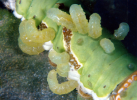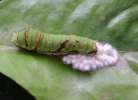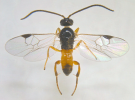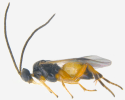Scientific name
Distatrix papilionis (Viereck) (=Apanteles papilionis Viereck)
Taxonomic position
Hymenoptera: Braconidae: Microgastrinae
Diagnosis
Images

 Larvae of D. papilionis emerging from the larva of citrus butterfly Larvae of D. papilionis emerging from the larva of citrus butterfly




 Cocoons of D. papilionis Cocoons of D. papilionis



 Adult - dorsal and lateral view Adult - dorsal and lateral view
Distribution
Widely distributed almost throughout India.
Biology / Hosts
Distatrix papilionis is a gregarious endoparasitoid of the citrus butterfly,
Papilio demoleus L. The parasitoid is arrhenotokous and prefers the first four larval instars for
parasitization. The larval development of the parasite was significantly influenced by the larval instars of the host. The duration of parasitic development decreased with increasing host age (instar) (Krishnamoorthy, 1987). The extent of parasitism varies from negligible to substantial levels and has a close association with minimum temperature and rainfall (Singh, 1994).
References
- Narayanamma, V.L., Savithri, P., Rao, A.R. 2003. Natural enemies and per cent parasitisation of citrus butterfly, Papilio demoleus on sweet orange and acid lime. Indian Journal of Entomology, 65(4): 461-464.
- Krishnamoorthy, A. 1987. Influence of different larval instars of Papilio demoleus L. on the development, oviposition and sex-ratio of the parasite Apanteles papilionis Viereck. Journal of Biological Control, 1(2): 75-79.
- Singh, S. P. 1994. Fifteen years of AICRP on biological control. Technical Bulletin No. 8, Project Directorate of Biological Control, Bangalore 24, India. 320 p.
|